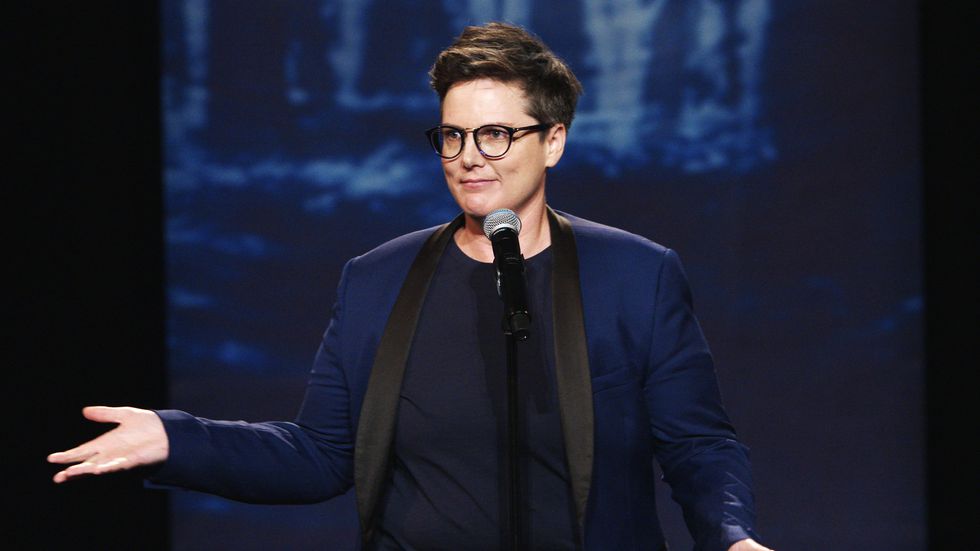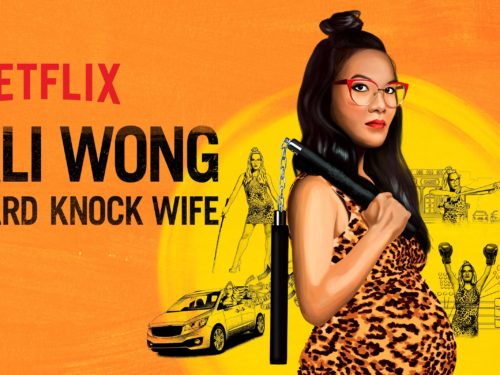In the middle of her Netflix special, Nanette, Hannah Gadsby recounts a time a male audience member at one of her shows told her to stop taking her medication for depression. He told her she was an artist and that her meds dampened her ability to create art. Gadsby, who studied art history in college, fought his point that Van Gogh wouldn’t have painted masterpieces if he took medication. Instead, she counters that (a) Van Gogh was on medication, and that (b) Van Gogh’s epilepsy medication made him perceive sunflowers as more yellow. “Perhaps we have the Sunflowers precisely because Van Gogh medicated,” she says.
The concept of human suffering being beneficial for art (comedy, in Gadsby’s case) is the crux of Nanette. Gadsby argues that the trauma she has gone through as a lesbian, a woman and a person with mental illness should not be minimized or readily recounted for an audience for laughs. Halfway through the special, she tells the audience that she’s quitting comedy. She’s tired, and instead of coating her story in jokes and physical gimmicks, she tells her story plain and simple. Gadsby may use the structure of stand-up comedy, but ultimately, this is a truth-telling exercise not aimed at generating laughs.
Plenty of critics have argued that Nanette isn’t quite stand up, or that its changing how people think about comedy. Some have argued that Gadsby’s performance is a one-woman theatre piece. But one thing that stands out regardless of the show’s format is Gadsby’s articulate and pointed critique of a society that marginalizes her for being different. And though she focuses mainly on her sexuality (“a little bit lesbian,” she jokes at the top of the set) and gender identity, her stories of grappling with mental illness shape its message as well.
Gadsby doesn’t think suffering is needed to create great art. But even then, she still recounts the actual violence she has faced. Early in Nanette, she describes an interaction with a man who yelled at her for sexuality. She makes a joke, brushing off the moment, and the audience laughs. But later, Gadsby finishes the story. The man beat her up and she never went to the hospital or reported it. And because of that, and other trauma she has recounted, Gadsby says she no longer will minimize her experiences in front of an audience and will instead tell the truth of her suffering.
“Punchlines need trauma, because punchlines need tension, and tension feeds trauma,” Gadsby says.
Gadsby’s critique of comedy, and of the ways society perceives self-deprecation, shows the master storyteller she is. She breaks down everything from the parts of a joke to her own traumas piece by piece, addressing the audience head on. Rarely does she turn away to take a sip of water. She acknowledges when the audience laughs with a small smirk. Her approach to storytelling is measured, but passionate, sly but full force.
In a Twitter thread, an audience member from an earlier Nanette performance detailed how Gadsby dealt with a heckler asking where her jokes were: she asked him to leave and donated the proceeds from his ticket to charity.
I saw #Nanette early last year at the Canberra theater. It was, as everyone has come to realise, incredible and to be honest I think I’m still processing it today. But I want to talk about one thing that happened on that night:
— Samara McCann (@Samara_McCann) July 5, 2018
“You learn from the part of the story you focus on,” Gadsby says. And though she tells her full story, the focus is never a punchline.
As someone who was diagnosed with bipolar disorder and anxiety before hitting elementary school, my sense of humor and creative instinct have always strayed away from my mental illness. I don’t like writing, talking about or creating art surrounding mental illness because it’s something I’ve always known. Why would I want to recount my trauma — something I am unable to fully articulate outside of my mind — when there are plenty of other meaningful things in this world to focus on?
Read more Split Tooth Media film reviews here
But Gadsby is, or at least she appears to an audience, able to tell her story — ugly parts that hit close to home included. Nanette is really only funny at the beginning, and even then, the humor comes from her delivery and not the content of her life.
In the hour-long special, Gadsby touches on growing up gay in Tasmania, Australia, where homosexuality was illegal until 1997, the sexual trauma she faced as a young person and her struggles with depression. Her strengths as a storyteller and comedian are on full display as she yells, exasperated, telling her story like her life depends on it. And in some ways, it does.
Gadsby’s ability to confront her demons in front of an audience at the Sydney Opera House and a Netflix audience shows strength in her vulnerability. This wasn’t her first time performing Nanette. The show ran at the Edinburgh Fringe Festival last summer. This Netflix special is the first time a truly international audience has been exposed to Gadsby’s material. But now she’s leaving it in the audience’s hands to do what they can with her story. At the end of her set, she says the reason she made Nanette was to have her story heard in hopes that people would reconsider their actions toward people who are different from the norm. Nanette may change the comedy industry in this way. It may not. But still, there’s something powerful about Gadbsy’s work — whether it makes any change or not.
“Do you know why we have the Sunflowers?” Gadsby asks. “It’s not because Vincent Van Gogh suffered. It’s because Vincent Van Gogh had a brother who loved him. Through all the pain, he had a tether, a connection to the world. And that is the focus… of the story we need: Connection.”
No one could have put it better.
Follow Sararosa on Twitter
Feature image courtesy of Netflix
(Split Tooth may earn a commission from purchases made through affiliate links on our site.)




